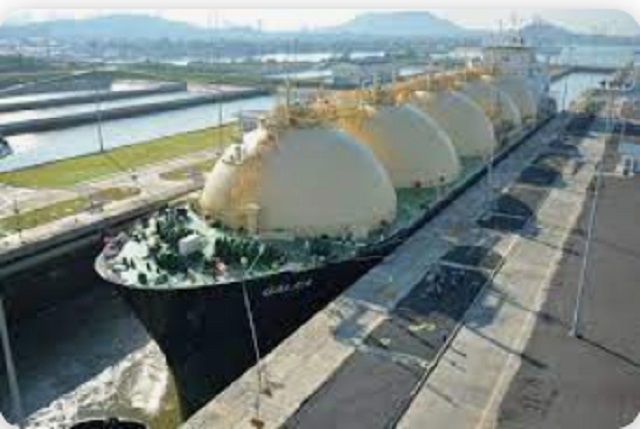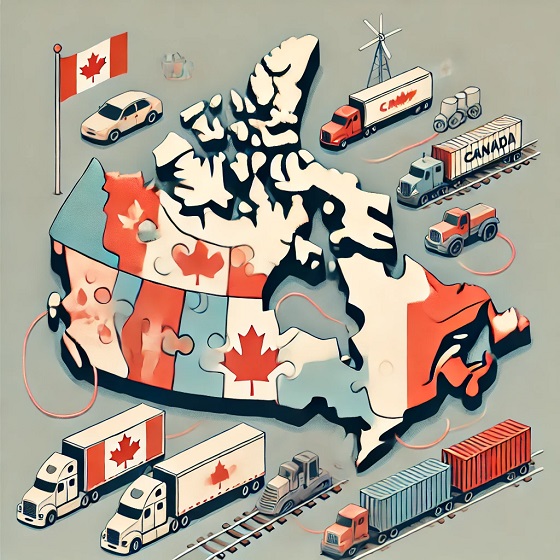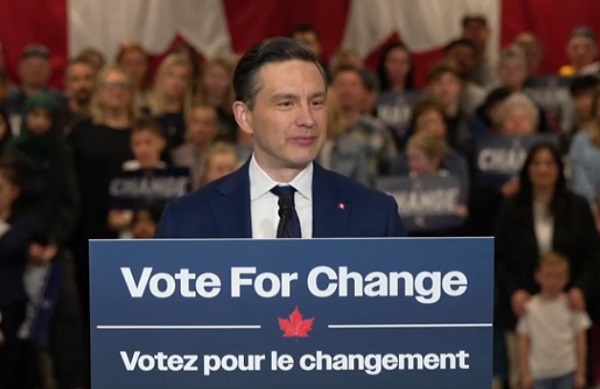Economy
Panama Canal drying up woes could have benefited Canadian LNG – If only we had any

From the Frontier Centre for Public Policy
There’s a disturbance in the force of global shipping, as if a major transit point started slipping away.
There’s a very serious problem occurring a few thousand miles to the south of us, one that Canada could have taken tremendous advantage of, if only we had built and completed some liquified natural gas (LNG) terminals by now.
The Panama Canal, one of the wonders of the modern world that utterly changed trade and geopolitics, is drying up.
The canal, which usually handles about 36 ships a day, has in recent days reduced that to 24. By Feb. 1, it is expected to fall to 18. And the largest ships who do transit the canal have to reduce their cargoes, lest they scrape bottom.
That’s because the canal uses fresh water, captured by dams and forming the massive Gatun Lake. That fresh water is collected from ample rains. Every single time a ship passes through the canal, water used to operate the locks is flushed into the ocean. While the greatly expanded third set of locks allows much, much larger ships to use the more than 100 year-old canal, they also use a lot of water despite an innovative water recovery system. And the Canal Authority says they’ve had the lowest rains in 73 years, since 1950.
So when you add up the additional, much larger locks, with a local drought, the canal is rapidly falling into crisis. And the world is starting to take notice.
As they should, since soon half of all ships that usually use the canal will be turned away.
No one depends on the canal more than the Americans. They built it, after all, for a reason. And one of the biggest is it allows for quick access for Gulf Coast ports to Pacific markets. This was a very real reason why building a half dozen large LNG terminals made so much sense (in addition to their proximity to gas production.)
Well, a lot of that just got thrown out the window. Cutting ship transit numbers by half means a dramatic curtailment of the ability of US LNG cargoes to access the Pacific markets. Their alternative is to add something like 8,000 miles going around South America’s Cape Horn, which absolutely no one wants to do due to the treacherous weather and seas.. Otherwise, they have to cross the Atlantic, Mediterranean, Red Sea, Indian Ocean and Straits of Malacca to get to east Asia markets.
The net effect will be some cargoes from the Gulf Coast destined for Asia will have to go much, much further to deliver their product. That means fewer cargoes per ship per year. It’ll tighten up ship availability, and likely put pressure on LNG prices.
And if Canada had moved quicker on building out LNG terminals, particularly on the West Coast, we would be perfectly positioned to cash in on this situation. Not only is Kitimat, Prince Rupert and the like much, much closer to China and Japan, there’s no drying up Panama Canal to contend with, either.
Small wonder, then, Conservative Leader Pierre Poilievre chose on November 10 to post on his various social media channels, “Since Trudeau took office: 18 LNG terminals have been proposed. 0 have been completed.”
To be fair, LNG Canada, the largest proposal, is in the finishing stretch. In July they reported 85 per cent completion. In recent weeks, TC Energy reported the completion of the “golden weld” on the Coastal GasLink pipeline that will supply LNG Canada and presumably other facilities on the West Coast. Without pipeline, which was both massively delayed and overbudget, no small thanks to pipeline protesters, LNG Canada would be useless.
Other projects are finally gaining traction – Woodfibre LNG at Squamish on the south coast, and Ksi Lisims LNG right on the Alaska/BC border, and Cedar LNG, a floating LNG terminal adjacent to LNG Canada and served by Coastal GasLink.
Remember when the German chancellor came to Canada, seeking LNG, and was told by Prime Minister Justin Trudeau there was “no business case?” And then the Japanese prime minister was told something similar a few weeks later?
The Ukraine War has proven a business case for almost two years in the Atlantic basin. The Panama Canal reduction in service will soon prove it in the Pacific. What more do we need?
Canada should have built these projects years ago. We’d be securing markets and cashing in today.
No business case, indeed.
Brian Zinchuk is editor and owner of PipelineOnline.ca, and occasional contributor to the Frontier Centre for Public Policy. He can be reached at [email protected].
Business
It Took Trump To Get Canada Serious About Free Trade With Itself

From the Frontier Centre for Public Policy
By Lee Harding
Trump’s protectionism has jolted Canada into finally beginning to tear down interprovincial trade barriers
The threat of Donald Trump’s tariffs and the potential collapse of North American free trade have prompted Canada to look inward. With international trade under pressure, the country is—at last—taking meaningful steps to improve trade within its borders.
Canada’s Constitution gives provinces control over many key economic levers. While Ottawa manages international trade, the provinces regulate licensing, certification and procurement rules. These fragmented regulations have long acted as internal trade barriers, forcing companies and professionals to navigate duplicate approval processes when operating across provincial lines.
These restrictions increase costs, delay projects and limit job opportunities for businesses and workers. For consumers, they mean higher prices and fewer choices. Economists estimate that these barriers hold back up to $200 billion of Canada’s economy annually, roughly eight per cent of the country’s GDP.
Ironically, it wasn’t until after Canada signed the North American Free Trade Agreement that it began to address domestic trade restrictions. In 1994, the first ministers signed the Agreement on Internal Trade (AIT), committing to equal treatment of bidders on provincial and municipal contracts. Subsequent regional agreements, such as Alberta and British Columbia’s Trade, Investment and Labour Mobility Agreement in 2007, and the New West Partnership that followed, expanded cooperation to include broader credential recognition and enforceable dispute resolution.
In 2017, the Canadian Free Trade Agreement (CFTA) replaced the AIT to streamline trade among provinces and territories. While more ambitious in scope, the CFTA’s effectiveness has been limited by a patchwork of exemptions and slow implementation.
Now, however, Trump’s protectionism has reignited momentum to fix the problem. In recent months, provincial and territorial labour market ministers met with their federal counterpart to strengthen the CFTA. Their goal: to remove longstanding barriers and unlock the full potential of Canada’s internal market.
According to a March 5 CFTA press release, five governments have agreed to eliminate 40 exemptions they previously claimed for themselves. A June 1 deadline has been set to produce an action plan for nationwide mutual recognition of professional credentials. Ministers are also working on the mutual recognition of consumer goods, excluding food, so that if a product is approved for sale in one province, it can be sold anywhere in Canada without added red tape.
Ontario Premier Doug Ford has signalled that his province won’t wait for consensus. Ontario is dropping all its CFTA exemptions, allowing medical professionals to begin practising while awaiting registration with provincial regulators.
Ontario has partnered with Nova Scotia and New Brunswick to implement mutual recognition of goods, services and registered workers. These provinces have also enabled direct-to-consumer alcohol sales, letting individuals purchase alcohol directly from producers for personal consumption.
A joint CFTA statement says other provinces intend to follow suit, except Prince Edward Island and Newfoundland and Labrador.
These developments are long overdue. Confederation happened more than 150 years ago, and prohibition ended more than a century ago, yet Canadians still face barriers when trying to buy a bottle of wine from another province or find work across a provincial line.
Perhaps now, Canada will finally become the economic union it was always meant to be. Few would thank Donald Trump, but without his tariffs, this renewed urgency to break down internal trade barriers might never have emerged.
Lee Harding is a research fellow with the Frontier Centre for Public Policy.
Alberta
Low oil prices could have big consequences for Alberta’s finances

From the Fraser Institute
By Tegan Hill
Amid the tariff war, the price of West Texas Intermediate oil—a common benchmark—recently dropped below US$60 per barrel. Given every $1 drop in oil prices is an estimated $750 million hit to provincial revenues, if oil prices remain low for long, there could be big implications for Alberta’s budget.
The Smith government already projects a $5.2 billion budget deficit in 2025/26 with continued deficits over the following two years. This year’s deficit is based on oil prices averaging US$68.00 per barrel. While the budget does include a $4 billion “contingency” for unforeseen events, given the economic and fiscal impact of Trump’s tariffs, it could quickly be eaten up.
Budget deficits come with costs for Albertans, who will already pay a projected $600 each in provincial government debt interest in 2025/26. That’s money that could have gone towards health care and education, or even tax relief.
Unfortunately, this is all part of the resource revenue rollercoaster that’s are all too familiar to Albertans.
Resource revenue (including oil and gas royalties) is inherently volatile. In the last 10 years alone, it has been as high as $25.2 billion in 2022/23 and as low as $2.8 billion in 2015/16. The provincial government typically enjoys budget surpluses—and increases government spending—when oil prices and resource revenue is relatively high, but is thrown into deficits when resource revenues inevitably fall.
Fortunately, the Smith government can mitigate this volatility.
The key is limiting the level of resource revenue included in the budget to a set stable amount. Any resource revenue above that stable amount is automatically saved in a rainy-day fund to be withdrawn to maintain that stable amount in the budget during years of relatively low resource revenue. The logic is simple: save during the good times so you can weather the storm during bad times.
Indeed, if the Smith government had created a rainy-day account in 2023, for example, it could have already built up a sizeable fund to help stabilize the budget when resource revenue declines. While the Smith government has deposited some money in the Heritage Fund in recent years, it has not created a dedicated rainy-day account or introduced a similar mechanism to help stabilize provincial finances.
Limiting the amount of resource revenue in the budget, particularly during times of relatively high resource revenue, also tempers demand for higher spending, which is only fiscally sustainable with permanently high resource revenues. In other words, if the government creates a rainy-day account, spending would become more closely align with stable ongoing levels of revenue.
And it’s not too late. To end the boom-bust cycle and finally help stabilize provincial finances, the Smith government should create a rainy-day account.
-

 Alberta11 hours ago
Alberta11 hours agoGovernments in Alberta should spur homebuilding amid population explosion
-

 International10 hours ago
International10 hours agoHistory in the making? Trump, Zelensky hold meeting about Ukraine war in Vatican ahead of Francis’ funeral
-

 conflict2 days ago
conflict2 days agoTrump tells Zelensky: Accept peace or risk ‘losing the whole country’
-

 Alberta10 hours ago
Alberta10 hours agoLow oil prices could have big consequences for Alberta’s finances
-

 2025 Federal Election2 days ago
2025 Federal Election2 days agoPoilievre Campaigning To Build A Canadian Economic Fortress
-

 Automotive2 days ago
Automotive2 days agoCanadians’ Interest in Buying an EV Falls for Third Year in a Row
-

 2025 Federal Election1 day ago
2025 Federal Election1 day agoAs PM Poilievre would cancel summer holidays for MP’s so Ottawa can finally get back to work
-

 armed forces21 hours ago
armed forces21 hours agoYet another struggling soldier says Veteran Affairs Canada offered him euthanasia






